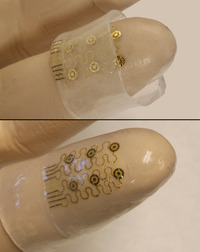In the future, ‘surgery at your fingertips’ could be literally true. Researchers at the University of Illinois at Urbana-Champaign have created a silicon nanomembrane that can be fitted onto the fingertips and could, one day, be used in surgical procedures. From the Aug. 9, 2012 news item on ScienceDaily,
The intricate properties of the fingertips have been mimicked and recreated using semiconductor devices in what researchers hope will lead to the development of advanced surgical gloves.
The devices, shown to be capable of responding with high precision to the stresses and strains associated with touch and finger movement, are a step towards the creation of surgical gloves for use in medical procedures such as local ablations [excising or removing tissue] and ultrasound scans.
Researchers from the University of Illinois at Urbana-Champaign, Northwestern University and Dalian University of Technology have published their study August 10, in IOP [Institute of Physics] Publishing’s journal Nanotechnology.
The Aug. 10,2012 posting on the IOP website offers this detail about the research,
The electronic circuit on the ‘skin’ is made of patterns of gold conductive lines and ultrathin sheets of silicon, integrated onto a flexible polymer called polyimide. The sheet is then etched into an open mesh geometry and transferred to a thin sheet of silicone rubber moulded into the precise shape of a finger.
This electronic ‘skin’, or finger cuff, was designed to measure the stresses and strains at the fingertip by measuring the change in capacitance – the ability to store electrical charge – of pairs of microelectrodes in the circuit. Applied forces decreased the spacing in the skin which, in turn, increased the capacitance.
The fingertip device could also be fitted with sensors for measuring motion and temperature, with small-scale heaters as actuators for ablation and other related operations
The researchers experimented with having the electronics on the inside of the device, in contact with wearer’s skin, and also on the outside. They believe that because the device exploits materials and fabrication techniques adopted from the established semiconductor industry, the processes can be scaled for realistic use at reasonable cost.
“Perhaps the most important result is that we are able to incorporate multifunctional, silicon semiconductor device technologies into the form of soft, three-dimensional, form-fitting skins, suitable for integration not only with the fingertips but also other parts of the body,” continued Professor Rogers [John Rogers, co-author of the study].
Here’s what an image of these e-fingertips,

Virtual touch. Electronic fingertips could one day allow us to feel virtual sensations. Credit: John Rogers/University of Illinois at Urbana-Champaign
Krystnell A offers a more detailed description of the e-fingetips in an Aug. 9, 2012 story for Science NOW,
Hoping to create circuits with the flexibility of skin, materials scientist John Rogers of the University of Illinois, Urbana-Champaign, and colleagues cut up nanometer-sized strips of silicon; implanted thin, wavy strips of gold to conduct electricity; and mounted the entire circuit in a stretchable, spider web-type mesh of polymer as a support. They then embedded the circuit-polyimide structure onto a hollow tube of silicone that had been fashioned in the shape of a finger. Just like turning a sock inside out, the researchers flipped the structure so that the circuit, which was once on the outside of the tube, was on the inside where it could touch a finger placed against it.
To test the electronic fingers, the researchers put them on and pressed flat objects, such as the top of their desks. The pressure created electric currents that were transferred to the skin, which the researchers felt as mild tingling. That’s a first step in creating electrical signals that could be sent to the fingers, which could virtually recreate sensations such as heat, pressure, and texture, the team reports online today in Nanotechnology.
…
Rogers says another application of the technology is to custom fit the “electronic skin” around entire organs, allowing doctors to remotely monitor changes in temperature and blood flow. Electronic skin could also restore sensation to people who have lost their natural skin, he says, such as burn victims or amputees.
Here’s a link to the article which is freely accessible for 30 days after publication, from the Aug. 9, 2012 news item on ScienceDaily,
Ming Ying, Andrew P Bonifas, Nanshu Lu, Yewang Su, Rui Li, Huanyu Cheng, Abid Ameen, Yonggang Huang, John A Rogers. Silicon nanomembranes for fingertip electronics. Nanotechnology, 2012; 23 (34): 344004 DOI: 10.1088/0957-4484/23/34/344004
My best guess is that free access will no longer be available by Sept. 7 (or so) , 2012. I last wrote about John Rogers’ work in an Aug. 12, 2011 posting about electronic tattoos.